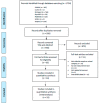Prevalence and Predictors of Burnout in Midwives: A Systematic Review and Meta-Analysis
- PMID: 31963831
- PMCID: PMC7013833
- DOI: 10.3390/ijerph17020641
Prevalence and Predictors of Burnout in Midwives: A Systematic Review and Meta-Analysis
Abstract
The prevalence of burnout in midwives has been briefly studied. Given the negative effects of burnout syndrome in the physical and mental health, and also related to the quality of care provided, rates of absenteeism and sick leave; identifying related factors for the syndrome are needed. The aim was to determine the prevalence, levels, and factors related to the burnout syndrome, measured with the Copenhagen Burnout Inventory in midwives. A systematic review and meta-analysis were selected from CINAHL, LILACS, ProQuest, PsycINFO, PubMed, SciELO, and Scopus databases, with the search equation "burnout AND (midwife OR midwives OR nurses midwives)". Fourteen articles were found with a total of 8959 midwives. Most of the studies showed moderate levels of personal burnout. The prevalence obtained was 50% (95% CI = 38-63) for personal burnout; 40% (95% CI = 32-49) for work-related burnout; and 10% (95% CI = 7-13) for client-related burnout. Midwives' age, less experience, and living alone constitute the main related factors, as well as, the scarcity of resources, work environment, and the care model used. Most midwives present personal and work-related burnout, which indicates a high risk of developing burnout. Personal factors and working conditions should be taken into account when assessing burnout risk profiles of midwives.
Keywords: burnout; meta-analysis; midwife; predictors; systematic review.
Conflict of interest statement
The authors declare no conflict of interest.
Figures
References
-
- Maslach C., Jackson S.E. The measurement of experienced burnout. J. Organ. Behav. 1981;2:99–113. doi: 10.1002/job.4030020205. - DOI
-
- Stamm B.H. The Concise ProQOL Manual. [(accessed on 3 November 2019)];2010 Available online: https://proqol.org/uploads/%0AProQOLManual.pdf.
-
- Kristensen T.S., Borritz M., Villadsen E., Christensen K.B. The Copenhagen Burnout Inventory: A new tool for the assessment of burnout. Work Stress. 2005;19:192–207. doi: 10.1080/02678370500297720. - DOI





